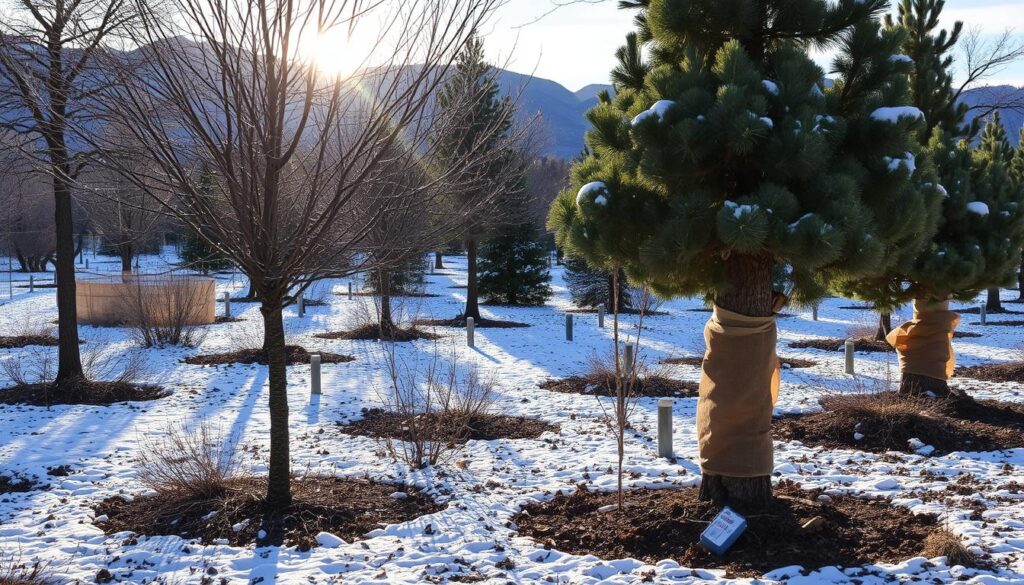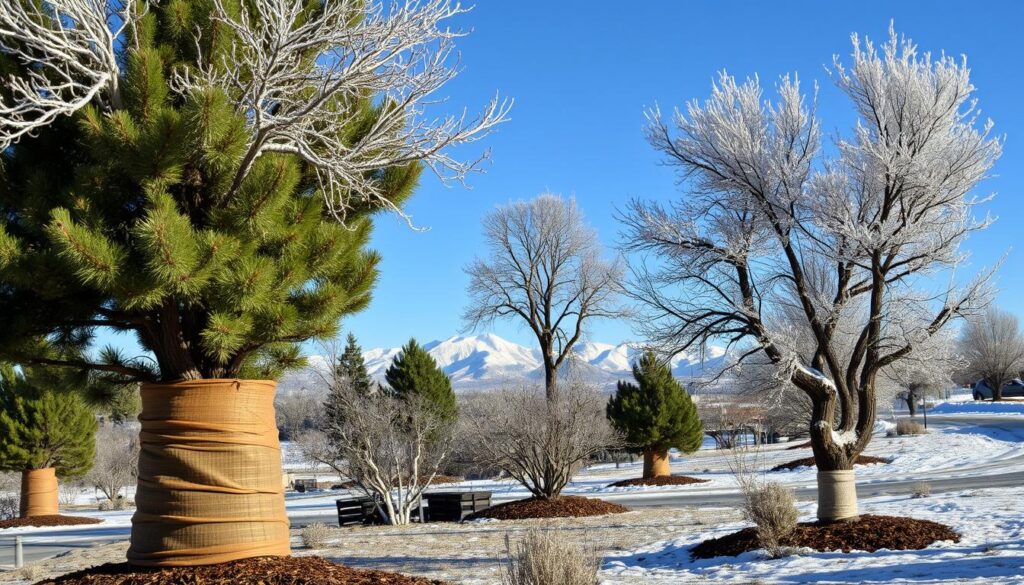
Winter in Prescott, Arizona, presents unique challenges for tree care. The cool mountain air and occasional freezing temperatures can harm local trees. It’s vital to protect trees during this time to keep landscapes healthy in the high-desert climate.
Experts in Prescott arboriculture stress the need for early action. By using frost prevention strategies, property owners can protect their trees from harsh winter conditions. Techniques like proper watering and pruning help trees stay strong during the cold months.
Knowing the specific needs of Prescott’s trees is crucial for winter protection. Each tree type has its own cold tolerance and care needs. By customizing your care, you can help your trees fight off frost damage and stay healthy.
Key Takeaways
- Winter tree protection is essential in Prescott’s high-desert climate
- Proactive frost prevention measures can significantly reduce tree damage
- Tailored care techniques are necessary for different tree species
- Proper watering and pruning are crucial components of cold-weather tree care
- Understanding local climate patterns helps in developing effective protection strategies
Understanding Frost Damage Risks in Prescott’s Climate
The Prescott winter climate is tough on trees. Freezing temperatures are common, making it key to know which trees are most at risk.
Typical Winter Temperature Patterns
Prescott’s winters are cold, with nights often below freezing. Daytime temperatures can swing, stressing trees. This makes frost damage more likely, especially for trees not native to the area.
Frost Effects on Tree Species
Each tree reacts differently to frost. Trees like pines and junipers usually handle Prescott’s winters well. But deciduous trees might get bark splits or bud damage. Fruit trees are especially at risk, as frost can harm flower buds and cut fruit yields.
Critical Freezing Points
Every tree has a temperature limit where damage starts. For many local trees, this is between 28°F and 32°F. Trees below these points for too long can suffer severe damage or even die, especially if they’re young or stressed.
- Pines: Generally hardy to 0°F
- Oak trees: Can withstand temperatures as low as 20°F
- Fruit trees: Often susceptible to damage at 28°F
Knowing these limits helps plan how to protect your trees in Prescott’s cold. By understanding what your trees need, you can reduce frost damage and keep them healthy all winter. Make sure to read this outstanding article.
Winter Tree Care Frost Damage Prevention
Prescott’s chilly winters can be tough on trees. Smart frost protection methods are key to keeping your trees healthy. A good winter tree maintenance plan starts with understanding your trees’ needs.

Cold weather tree prep is all about timing. Start your freeze damage prevention efforts before the first frost hits. This means wrapping trunks, mulching roots, and adjusting your watering schedule.
Here are some effective frost protection methods:
- Wrap young tree trunks with burlap or tree wrap
- Apply a thick layer of mulch around the base of trees
- Water deeply but less often during cold months
- Prune dead or diseased branches before winter sets in
Remember, different trees need different care. Native species might need less help than non-native ones. Your winter tree maintenance plan should take this into account.
With the right cold weather tree prep, you can help your trees survive Prescott’s frosty winters. Stay tuned for more detailed tips on each aspect of winter tree care.
Essential Pre-Winter Tree Maintenance Steps
Getting your trees ready for winter is key to avoiding frost damage and keeping them healthy. By acting early, you can shield your trees from harsh weather and help them live longer.
Proper Pruning Techniques
Winter pruning helps trees handle cold better. Cut off dead, sick, or crossing branches to boost air flow and lower ice and snow damage risk. Try to thin out the leaves instead of cutting too much to keep the tree’s shape.
Soil Management and Mulching
Soil insulation is crucial for protecting tree roots from freezing. Spread a 2-4 inch layer of organic mulch around the tree, up to the drip line. This method has many benefits:
- Regulates soil temperature
- Retains moisture
- Suppresses weed growth
Root Zone Protection
Use root protection methods to keep sensitive roots safe from extreme cold. Make a barrier with burlap or landscape fabric around the tree’s base. This layer keeps soil temperature steady and stops frost heaving, which can harm roots.
By following these steps before winter, you’ll help your trees stay strong during the cold months. They’ll be ready to grow well when spring comes.
Protective Measures for Young and Vulnerable Trees

Young trees in Prescott need extra care during winter. Sapling protection is key to their survival in harsh conditions. Tree wrapping is a good way to protect tender bark from cold and sun scald.
To wrap a tree, start at the base and move up, overlapping as you go. This creates a barrier against cold winds and frost. Use breathable materials like burlap or tree wrap for the best results.
Frost blankets also help protect vulnerable trees. They trap heat and moisture, creating a warm spot around the plant. Make sure to secure them well to avoid wind damage.
- Cover the entire tree, from top to bottom
- Remove blankets during the day to allow sunlight
- Replace at night when temperatures drop
Wind barriers are vital for young trees to avoid drying winter winds. Use stakes and burlap to create a shield around your sapling. This will reduce wind exposure and keep the soil moist.
Don’t forget to remove all protective measures in spring. This lets your trees grow healthily. With these techniques, your young trees will thrive through Prescott’s cold season.
Watering Strategies During Prescott’s Cold Season
Winter tree hydration is key in Prescott’s cold season. Trees still need water even when they’re dormant. Proper watering helps avoid drought stress and frost damage.
Optimal Watering Times in Winter
Water trees on warmer days when the ground isn’t frozen. Mid-morning is best, letting water soak in before it freezes at night. Water once or twice a month, based on how much rain you get.
Moisture Management Techniques
Keeping moisture in is important in winter. Spread a 3-4 inch layer of mulch around the tree base, but leave space near the trunk. This keeps roots warm and holds moisture. Use drip irrigation or soaker hoses for slow, deep watering.
- Water deeply but less frequently
- Avoid overwatering to prevent root rot
- Check soil moisture regularly with a moisture meter
Signs of Winter Dehydration
Look out for signs of drought stress in your trees. If branches are brittle or leaves are curling, it’s a sign. Bark cracks also mean dehydration. If you see these signs, water more often while following winter watering tips.
Tree Wrapping and Physical Protection Methods
Winter in Prescott can be tough on trees. Tree wrapping techniques offer a shield against harsh conditions. Wrapping tree trunks with burlap or special tree wrap guards against frost damage and winter sunscald. This protection is crucial for young or thin-barked trees.
Burlap protection goes beyond trunk wrapping. It can create barriers around entire trees or shrubs. This method helps block cold winds and retain heat. For extra care, anti-desiccant sprays can be applied to evergreen foliage. These sprays form a protective coating that reduces moisture loss during dry, cold spells.
Winter sunscald prevention is key for trees with southern or western exposure. Reflect sunlight away from trunks using light-colored tree guards or paint. This stops bark from heating up on sunny winter days and cracking when temperatures drop at night. With these methods, Prescott tree owners can give their trees a fighting chance against winter’s worst.
Yavapai Landscaping Prescott offers complimentary estimates for Prescott and its nearby localities for landscaping and tree services, ranging from tree removal, trimming, stump grinding, land clearing, and storm cleanup to emergency tree care.
